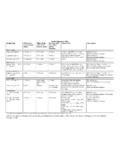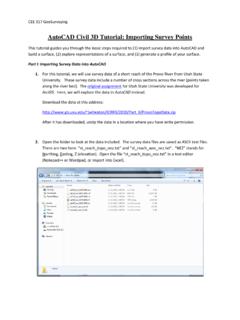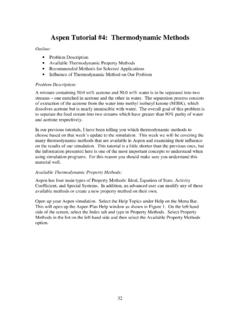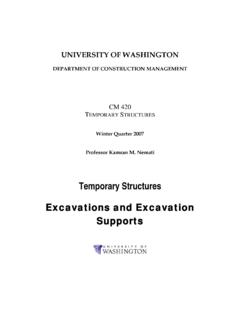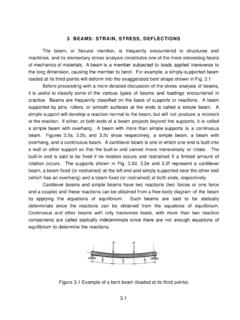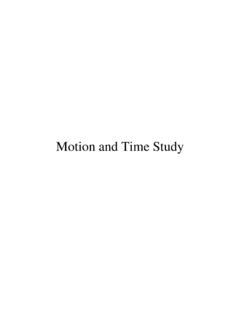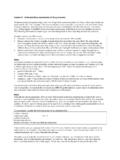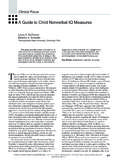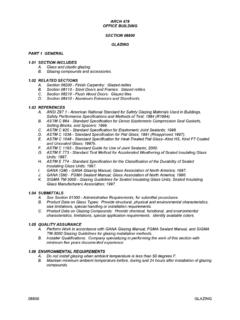Transcription of The Oscilloscope and the Function Generator
1 TheOscilloscope andtheFunctionGenerator:Someintroductory exercisesforstudents in theadvancedlabsIntroductionSomany of theexperiments in theadvancedlabsmake useof oscilloscopes andfunctiongeneratorsthatit is speci ablevoltageappliedover a speci abletime,such as a \sinewave" or \trianglewave" controlotherapparatusto,forexample,varya magnetic eld(superconductivity andNMRexperiments)senda radioactive sourceback andforth(M ossbauere ectexperiment),or actas a timingsignal, ,\clock"(phase-sensitive detectionexperiment).Oscilloscopes area type ofsignalanalyzer|theyshow theexperimentera pictureof thesignal,usuallyin theformof a learntheamplitude,frequency, andoverallshape of thesignalwhich may dependonthephysicsbeingexploredin themdateback to thebeginningsof electronicengineering,andtheirmoderndesc endants areoftendigitallybased,multifunctiondevi cescostingthousandsof exercisesis intendedto getyoustartedonsomeof thebasicsof operating'scopesandgenerators,butit takes a good dealof experienceto learnhow to operatethemwell andtakefulladvantageof ,whethertheoldanalogtype or thenewer digitaltype, have a fewcommonfeatures: A way to selecta waveformtype.
2 Sine,square,andtrianglearemostcommon,but somewillgive ramps,pulses,\noise",or allow youto programa particulararbitraryshape. A way to selectthewaveformfrequency. 10 MHz. A way to selectthewaveformamplitude. At leasttwo \main"output,which is whereyou ndthedesiredwaveform,typicallyhasa maximumvoltageof 20voltspeak-to-peak,or themainoutputis 50 ohms,althoughlower outputimpedancescansometimesbe secondoutput,sometimescalled\sync",\aux" or \TTL"producesa squarewave withstandard0 and5 is usedforsynchronizinganotherdevice(such as anoscilloscope) to widevariety of otherfeaturesareavailableonmostmodernfun ctiongenerators,such as \fre-quencysweep"|theability to automaticallyvarythefrequencybetweena minimumandmaxi-mumvalue,\DCo set"|aknobthataddsa speci edamount of DCvoltageto thetime-varying1waveform,andextrainputso r outputsthatcanbe usedto controltheseextrafeaturesby basicsAlloscilloscopes to seewheretypicalcontrolsmay befound.
3 Themostrecognizablefeature:a thisis a cathode-ray tube orCRT;thesignalcreatesa movingdotor \trace" digitalscopesthescreenis a CRT or at-paneldisplay thatoperateslike a thescreenis to display thesignalsin a graticuleonit of about1 cmsquares. At leasttwo (maybe more)signalinputs,or \channels",typicallycalled\CH1",\CH2",et c.,andoneexternal\trigger"input,typicall ycalled\EXTTRIG". A collectionof controlsrelatedto verticalpartof thedisplay couplingto theinput:direct|\DC",througha capacitor|\AC",or disconnected|\GND".Theamount of ampli cationappliedto thesignalis controlledbya knob,andis speci edin termsof screenunits:a \10mV/div"settingmeansthata 10millivoltchangein theinputsignalwillmove thetraceverticallyby onemajordivision. A collectionof controlsrelatedto thehorizontalpartof thedisplay.
4 Thesecontrolssetthetimeaxisandarecalibra tedin secondsper division, ,1 s/divmeansthatonemajordivisioncorrespond sto1 \timebase"andthesettingis calledthe\sweeprate". A collectionof controlscalledthe\trigger"thatareusedto synchronizetheinputsignaltothehorizontal display. Becausethereis no xedrelationshipbetweenanexternalsignalan dtheinternaltimebase,thetriggermakes thescope waituntil someprescribed level in an inputis reachedbeforebeginningitsdisplay. Triggeringcontrolsarediscussedin additionto theabove featureswhich arecommonto bothanaloganddigitalvarieties,digitalosc illoscopes typicallycomewiththeability to save dataandcontrolsettingsto memory, performmathematicaloperationson datatraces,averagemany cyclestogetherto reducethee ectof random uctuations,andcarryoutautomaticmeasureme nts of frequencyandamplitudeof printoutsof thedisplay screento keepa paper recordof themeasurement.
5 Thebasicandadvancedfeaturesof oscilloscopes willbe exploredin : Front panellayoutsof thedigitalscope (top)andtheanalogscope (bottom).3 GettingstartedIn thisexerciseyou willlook at thetypes of signalsavailablefroma generatorandexplorethebasiccontrolsof to seethatyouhave thefollowingequipment at yourstation: Onedigitaloscilloscope. Youmay have oneof thefollowing,allmadeby Tektronix:TDS320,TDS340,TDS360,TDS620 Bor TDS3012. Oneanalogoscilloscope. TheseareTektronixmodels2213A,2215A,or 2235. Two aremadeby Krohn-Hite,Wavetek,or Exactandareidenti ableby theirprominent aremadeby WavetekandStanfordResearch Systems(SRS)andareidenti ableby thedigitaldisplay andlargenumber of panelbuttons. Anoscilloscope probe. A scope probe isnotjusta wire witha clip, butit hasothercircuitryin it to modifythesignalbeforeit passesto thescope mostof theadvancedlabexperiments,thescope is wiredinto thesetupusingBNCcables,so youwon'tusea probein thesecases,butit is standardequipment whenusinga scope to studytheinternalsof acircuit.
6 A box of smallparts,which shouldhave a smallscrewdriver (possiblymadeof plastic),a fewresistors,a capacitor,somewiresandsomeBNCadaptors. A plug-incircuitboard(\breadboard")thatcan be usedto wireuptestcircuits. fewof variety of lengthsavailableonracksattachedto theback sideof 'sgetstartedby lookingat Turnona a fewsecondsto completeinternaltests,buttheanalogoneswi llbe readyright Turnon thedigitaloscilloscope. Afterthescope completesits internaltests,pressthe\Clearmenu"buttona t thelower right handcornerof thedisplay Geta coupleof BNCcablesfromthecablerack; six-foot lengthsshouldbe connectthe\main"outputof thegeneratorto CH1of theoscilloscope andthe\aux"(or\sync"or \TTL")outputto Setthecontrolsof thefunctiongeneratorto producea sinewave of about1000 Hzfrequencyanda ,here'show:ANALOG(Krohn-Hite,Wavetek,Exa ct)Usethe\waveform"or \ Function "switch to selectthesine(curvy-line)waveformtype.
7 Usethefrequencyadjustknobandmultiplierbu tton/switchto selectthefrequency, andthensettheamplitudeknob(\Ampl"or \Attenuator")at about12 o'clock, withany attenuatorswitchessetat (SRSDS345)Usethe4,5buttonsundertheFUNCTI ON menu ,andthenkeyin \1"followedby the4 Figure2: Digitalscope display of a 1 kHzsinewave froma functiongeneratoranditsassociated\sync" features:thechannel0-voltmarkers(\1!" and\2!");thetriggerindicators:the\T"in themiddleof thescreenandthesmallarrow on theright; thechannelsensitivities(volts/div),sweep time(sec/div)andtriggersettingsareshowna longthebottomofscreen:channel1 (\Ch11V")is showinga 2 voltpeak-to-peaksinewave, andchannel2 (\Ch25V")is showinga 0 to 5 voltsquarewave. Thesweeptimeis 500 s/div(\M500 s"),andthetriggeris setfora 20 mVpositive-goinglevel in channel1.
8 \kHz/Vrms" settheamplitude,presstheAMPL buttonfollowedby \2"andthe\kHz/Vrms" (Wavetek29)Selectthe\Sine" ,followedby \1"andthe\kHzusmV" pressingAMPL followedby \2"and\MHznsV".IMPORTANT:theWavetek29 willnotactivateitsmainoutputuntil youpresstheOUTPUT buttonat thelower right, above In orderto startfroma uniformsetting,resettheoscilloscope to itsfactorydefaultvaluesby pressingtheSAVE/RECALL button,andthenusingthesoftkeysto choosethe\factorydefault" turnonbothof , pressAUTOSET ontheoscilloscope to examinetheinputsandchoosea bestguessat display similarto thatshownin If youdon'tgetthis, vertical,horizontalandtriggercontrolsNow thatyouhave a signal,explorethee ectsof thevariousscope PresstheCH1buttonandseewhathappenswhenyo u attentionto boththechangesin thedisplayedwaveformandthetextindicators 5at thebottomof ableto deducethemeaningof PresstheCH2buttonandrepeattheabove You canturna waveformo by rstpressingthechannelselectorbutton(turn ingtheadjacentgreenLEDon),followedby this,andturno andthenonthewaveformsfromchannel1 thesettingof theSEC/DIVknob.
9 (Thesamplerateis therateat which thewaveformis digitized,andit mustbe notablyhigherthanthesweeprateforthetrace to be accuratelydrawn.)Alsonoticehow thebarindicatorandtrigger-positionindica torat thetopof thescreenchangesas youmove thePOSITION knob:thebarrepresents thescope'smemory, andtheregionbetweenthesquarebrackets[ ]representstheamount of theTDS300series,thescreenalwayslooksat a portionof thescope'stotalmemory;in theTDS600series,theamount of memoryvisibleonthescreenis adjustable(asanoptionundertheHORIZONTALM ENU);in theTDS3000series,thescreenalways looksat allof thescope'smemory, butyoucanzoominona smallpartof it withthe\magnify"option(underthebuttonwit hthemagnifyingglasssymbol).2. (TDS300andTDS600seriesonly) , so a triggeris to synchronizethescope'smeasurement tomeasurethetimedurationthata runnertakes to runthe rstpositionyourselfso thatyoucouldseetherunnerapproacha speci cmarker andthenstartyourtimeras ,youwouldwaituntil therunnermadea fulllapandreturnedto themarker youaremeasuring(100-metertimedurationove r successive laps)takea di erent amount of timethanthedurationof a fulllap,andmay startat di erent timepointsfromlapto lap,youneedto waitfora partof each lapfortherunnerto reach themarker triggerworksin a similarway.
10 Thescope waitsuntil theinputwaveformreachesa particularlevel or producesa particularpatternbeforestartingits\trace "ormeasurement tracesoccurafterwaitinguntil theoscilloscope triggeris themostdi cultskillforthenoviceto lookat thetriggercontrols,let' a scope'smeasurement in which a movingbright dotis createdon a CRT screenby an electron6beamde ectedunderthein uenceof theverticalandhorizontalampli digitalscopesthetraceis thevisualdisplay of thescope'sdatamemory. In general,a proper triggermustoccurbeforea traceis createdor coupledwiththe\slope" de nesthepatternthatmustbe sensedby thetriggercircuitbeforeit \positive slope" meansthatthetriggerlevelmustbe crossedgoingfroma lower to a highervoltage, ,\goingup";likewisea \negativeslope" meansthatthetriggerlevel mustbe crossedgoingfroma higherto a lower voltage:\goingdown".

